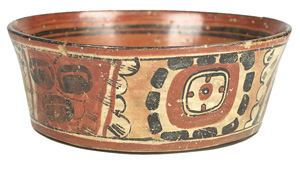Advances in Digital Imaging Technology for Archaeology, Architecture, and Art History
Wide-format Ink Jet color printers and Laser Printers
Nicholas Hellmuth, Director F.L.A.A.R. Digital Imaging Technology Center, St Louis, Missouri and Essen, Germany
Abstract of a Public Lecture available in German, English, or Spanish
Whereas most archaeological field projects and museums have gradually begun to incorporate digital cameras and digitized photographs into their projects, there is an entire other level of digital technology, collectively known as high-end digital imaging.
With today's user-friendly interfaces, high-end digital imaging is easier to learn. Although it is obviously an advantage if you already have experience in digital imaging, if you are patient, and dedicated, you can advance deep into this new era with no special background in computers whatsoever. The new hardware and software of digital imaging offers almost limit-less opportunities to improve classroom instruction, research, and enhance the publishing of research results in full color in short-run editions.
The focus of this presentation will be a little known development of high-end digital photography, namely a special camera and software that can do seamless circumferential photography of round objects. This camera 'rolls out' the complete circumferential decoration of a round object (such as a painted Maya vase or Nazca bowl) as a single horizontal image. Rollout cameras have been made since the last century and used increasingly since the 1930's. The capable 60 mm rollout photography of Justin Kerr is especially well known in the field of Maya studies. But the new digital system, independently developed by engineer Michael Collette for his company Better Light and for Dicomed, is one of the first times that peripheral photography has been done digitally. Just as there are countless film-based rollout systems, so also are digital systems now commonplace, as was evident at the recent Photokina international photography trade show in Cologne, Germany (October 1998). Of the various sytems, the one which has the most accessories and which is an actual production model (rather than just a prototype) is that of Better Light, an adaptation of the Field Pro licensed by Better Light to Dicomed.
This same digital system can also do seamless 360 degree photographs for virtual reality, with no need to stitch together individual segments of a panorama. It is also technologically possible to do linear photography with a system of this nature, adjusting the camera to a carriage, propelled by the turntable (set at 90 degrees), rolling along a small train-like track.
The turntable rollout mode will facilitate recording designs and techniques of such diverse kinds of ethnographic handicrafts as basket weaving as well as a considerable variety of round art, artifacts, and other objects. The new digital rollout system is also the first known case of this kind of a camera which can be tilted to record the inside decorations of wide-mouthed objects, such as large bowls or the hieroglyphic inscriptions on the inside sidewall of polychrome Maya plates.
 |
| Maya bowl |
 |
| Maya rollout from bowl above |
The lecture will also discuss the new class of wide-format digital printers which can reproduce digital photographs at dimensions of 3 feet wide and up to several meters long. We will display one rollout photograph of a Maya vase which was enlarged to 14 feet long (shot with a 70mm film camera and enlarged in a special darkroom). This will be compared and contrasted with printing in full color on readily available and increasingly more economical wide format ink jet printers such as Encad, Roland, ColorSpan, Mutoh, and other brands, run with PostScript RIP servers. Having such a printer for your own project means you can produce all kinds of facsimiles, posters, and other visual aids. The actual cost of ink and paper for a large poster-sized full-color print is about $7. It takes about 5 minutes to print in your own office.
All this equipment is displayed and reviewed on several web sites such as www.digital-photography.org and www.maya-archaeology.org
Professor Nicholas Hellmuth has held three honorary research positions at Yale University and is currently Research Associate, Dept of Anthropology, Washington University. Dr Hellmuth's speciality is Maya architecture and the iconography of Teotihuacan and Maya ceramic art. He is an independent beta-tester for leading photography, computer and printer companies. He was trained in digital imaging while Visiting Professor, National Museum of Ethnology, Osaka, Japan, on a grant from Japan's Ministry of Education.
This presentation is especially appropriate for students of anthropology, archaeology, art history who are interested in pre-Columbian culture of ancient Mesoamerica as well as for departments of architecture, photography, and digital graphics. The information, tips, and discussion are also appropriate for museum curators and field workers in botany, zoology, and geology. No special background in computers or prior preparation whatsoever is required.
This lecture is available anywhere in the world in German, English, or Spanish. e-mail [email protected]
This abstract prepared for a lecture presented at the 2nd Mesoamerican Symposium at the University of Bremen (northern Germany) and for the Dept, of Anthropology, Washington University (St Louis, Missouri). Both lectures were in April 1999. We are now expanding the coverage of this presentation to ethnographic objects and art history in general.
New page format posted November 20, 2009